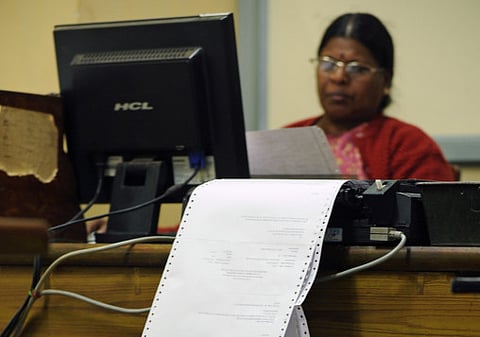Telegram comes to a full stop in India
160-year-old service to be discontinued from July 14

New Delhi: The postman is shown cycling in a hurry to convey the news. He knocks at the door and the hero comes out. Anxiously, he takes the telegram (taar, the common Indian term) from the postman, and reads: MOTHER SERIOUS STOP START IMMEDIATELY STOP. A telegram’s arrival was the foundation stone of many a cinematic moment. As in reel life, so also in real life, a telegram’s arrival brought in varied emotions.
A telegram was a pink or white rectangular sheet folded and sealed. The message was in a few words, in ALL CAPS. For a start, the recipient would almost always open the telegram with trembling hands. Not only was there an element of urgency about a telegram, but also a lingering fear, expecting the worst. Though for over 160 years, it brought news of joy and success as well.
And now, come mid-July — it will be a FULL STOP for the telegram.
While the computer and iPad generation is wondering what the uproar is all about, the not so young are getting all nostalgic about the telegram being soon given a burial. With the advent of technology and newer means of communication via smart phones, the telegram will soon only be found in history books, school curriculum and museums.
As per a circular issued by Shameem Akhtar, senior general manager (Telegraph Services), Bharat Sanchar Nigam Ltd (BSNL) Corporate office, New Delhi, the telegraph is being discontinued with effect from July 15, 2013.
Akhtar said, “We have better ways of communication these days, which are reliable and faster. Telegrams have become redundant.”
The chatter of the telegraph machine, though, stopped long before and old machines are not found anywhere. Even the teleprinters, which replaced them have disappeared. The services were modernized in the 1990s and messages are now fed into a computer and the telegrams are computer-generated. Taken out from printers, the messages are inserted in envelopes and delivered by postmen in cities and villages.
Big loss
The telegram’s winding up orders have come after the department witnessed a loss of Rs14.73 billion since 2006-07. It suffered a 72 per cent decline in traffic – from 21,785 telegrams in 2006-07 being sent out in a day on an average to 6,038 in 2010-11.
To minimize the loss, the rate per telegram was revised from Rs3 per 30 words to Rs25 per 30 words — the first time in 60 years. BSNL had also ended its international service in 2011. But the figures kept declining further.
The significant increase in price could not make the telegraph services self-sustainable. Says S L Chhokar, sub divisional engineer (telegraph service), “Had the government increased the rates earlier, the damage would not have been done.”
Understandably, the mood inside the Central Telegraph Office (CTO) in Eastern Court building at Janpath, is somber.
Chhatrapal, a telegraph operator, is due for retirement this December after 37 years of service. Questioning the decision of the government, he says, “Why do they not shut other departments and services that are going in loss? Why single out just the telegram?
Telegram is a heritage and it is a pity that they are bent upon destroying it.”
Till 2008, CTO had 22,000 people, who worked day and night. Now there are only over 900 employees all over India and work has shrunk to 8-9 hours.
In the 1990s, BSNL had taken charge of the telegram services from the department of posts. But fax, emails and SMSs pushed the telegram into difficulty where it struggled to survive. BSNL has plans to shift the staff and deploy them to mobile services, landline telephony and broadband services, within the next three months.
Rohtash Verma, 59, who has been working in the department for over 41 years, said, “The telegram service was at its peak in 1985-86, when around 150,000 telegrams were sent on a daily basis from the CTO alone, but now it is just few hundred.
Verma apprised about certain codes to convey sentiments to save money. For example, the code for a person’s death was 100 and a birthday greeting was 5. He also showed bundles of telegrams that are kept as record. “These are destroyed after a year,” he said.
Not knowing, where he would be posted next, Verma controls his emotions. In a light-hearted vein he says, “They should have SMSd to say that the vintage service of telegrams was being terminated!”
Sign up for the Daily Briefing
Get the latest news and updates straight to your inbox



